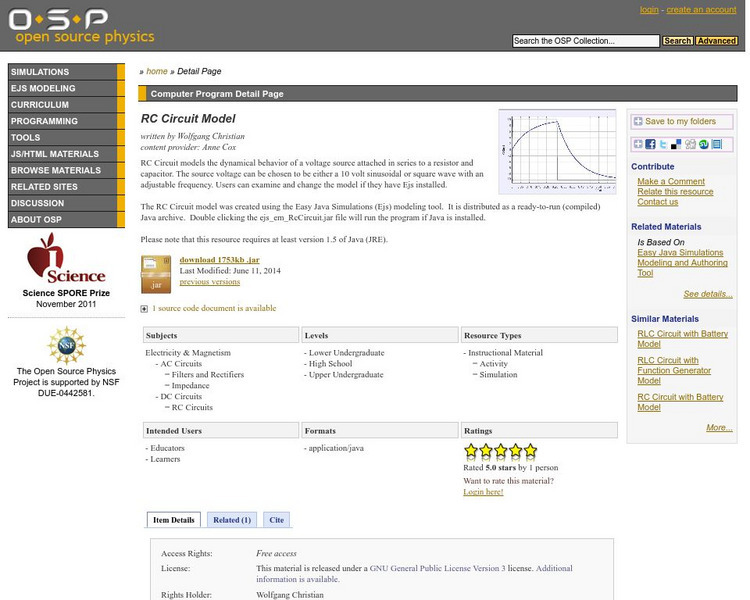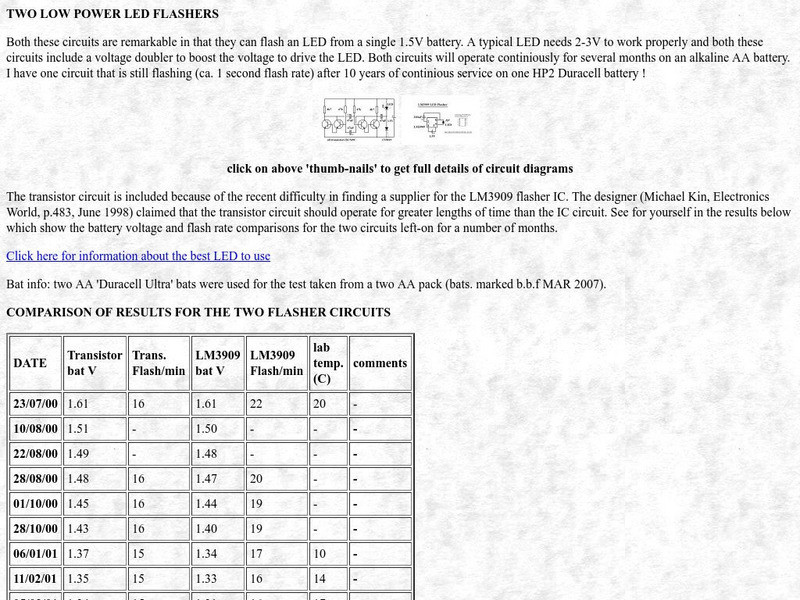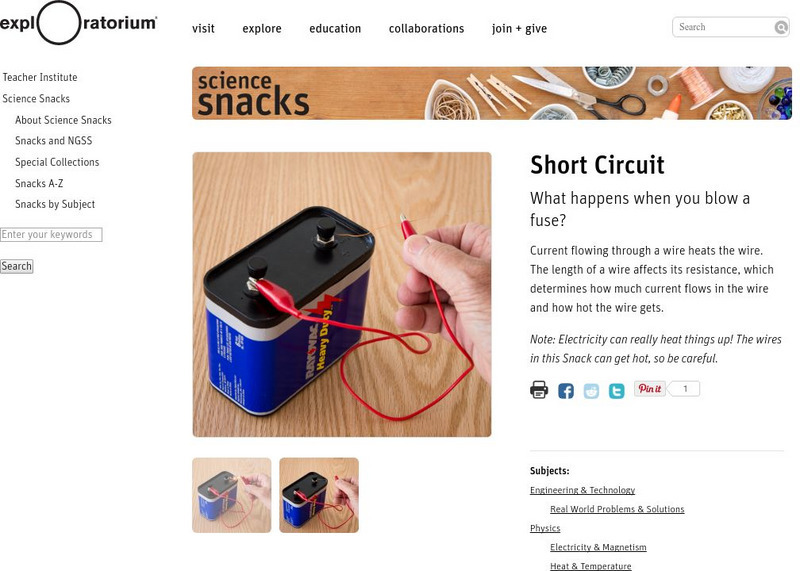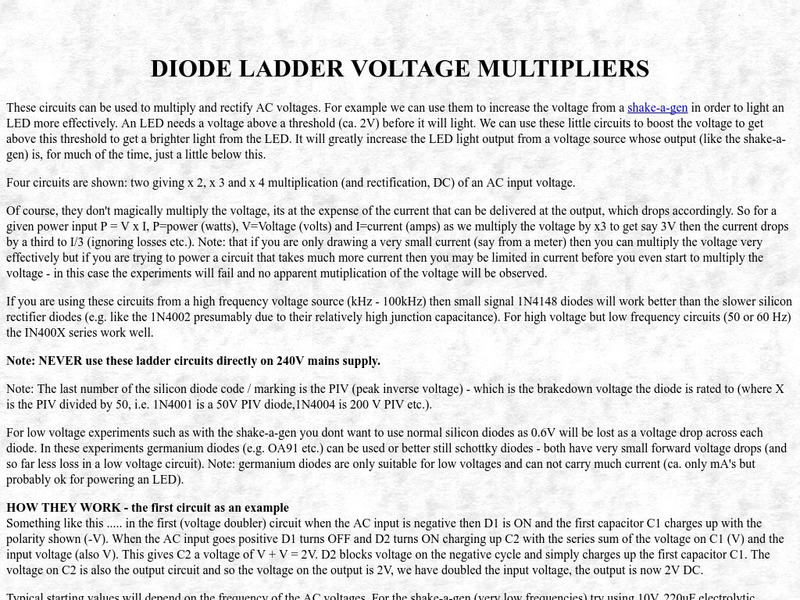Science Buddies
Science Buddies: Project Ideas: Which Materials Are the Best Conductors?
A simple science fair project to test whether electricity can flow between two things. The Science Buddies project ideas are set up consistently beginning with an abstract, objective, and introduction, followed by a section on terms,...
Science Buddies
Science Buddies: Solar Cell Power Output vs. Temperature
Solar cells provide a clean way of making electricity directly from sunlight. In this project you will build a simple circuit and experimental setup to investigate whether the power output of a solar cell changes with ambient temperature.
Science Buddies
Science Buddies: Where There Is Charge, There Can Be Sparks!
In this short science project you will learn how to build a capacitor using common household items. By testing different charge cycles, you will work to discover how much charge is stored in a Leyden jar capacitor.
Science Buddies
Science Buddies: Waste Not, Want Not: Use the Microbial Fuel Cell to Create Elec
Gross. What is that in the toilet? But maybe it's not just gross. Did you know there are bacteria that digest organic waste and create electrons? What if there was a way to collect those electrons to power a circuit? In this science fair...
CK-12 Foundation
Ck 12: Physical Science: Series and Parallel Circuits
[Free Registration/Login may be required to access all resource tools.] What series and parallel circuits are and how they differ.
E-learning for Kids
E Learning for Kids: Science: Norway: What Happens When Parts of a Circuit Are Changed?
Join Mathias as he takes care of the electrical problems in his uncle's office. Help him figure it out, and fix the lights.
American Association of Physics Teachers
Com Padre Digital Library: Open Source Physics: Rc Circuit Model
An electrical circuit simulation modeling the behavior of a voltage source attached in a series to a resistor and capacitor.
Project Britain
Primary Homework Help: Electricity Questions
Brush up on electricity facts before taking this interactive quiz. Students can get immediate feedback by checking the answers after each question.
Massachusetts Institute of Technology
Mit: Open Course Ware: Courses: Introduction to Electric Power Systems
College-level electrical engineering course highlighting electric power systems. Course introduces electric power and the conversion of electrical to mechanical energy. Course features include readings, assignments, and quizzes.
Science Struck
Science Struck: Chart of Electrical Symbols With Their Meanings
A useful list of electrical symbols that are used in schematic diagrams. Each symbol is accompanied by its name and a caption stating its function.
Creative Science Centre
Creative Science Centre: Two Low Power Led Flashers
Explains the design of two circuits that can flash an LED from a single 1.5V battery. A typical LED needs 2-3V to work properly and both these circuits include a voltage doubler to boost the voltage to drive the LED. Both circuits will...
Science Museum, London
Science Museum: Robot Bugs
Build a robot and watch how it moves. Activity is designed to help students learn how electrical circuits and switches control how things move.
Maryland Science Center
Maryland Science Center: Build a Conductivity Tester [Pdf]
Instructions on how to build an instrument that can be used to test which materials are conductors and which are insulators, in order to bridge a gap in an electrical circuit.
CK-12 Foundation
Ck 12: Fourth Grade Science
This customizable digital textbook covers topics related to fourth-grade science. It is Next Generation Science Standards (NGSS) aligned.
Science Education Resource Center at Carleton College
Serc: Investigating Electricity: Building Circuits in Elementary Science Class
In this exploration activity, students compare the difference between series circuits and parallel circuits using wire, light bulbs, and D batteries.
Khan Academy
Khan Academy: Electrical Engineering: Circuit Analysis
Circuit analysis is the process of finding all the currents and voltages in a network of connected components. We look at the basic elements used to build circuits, and find out what happens when elements are connected together into a...
Hunkins Experiments
Hunkin's Experiments: Electric Shocks!!
Hunkin's Experiments is a group of simple cartoon illustrations of scientific principles. Some would work well in the classroom, but others have little value beyond entertaining students. All of the projects are easy to do. These...
Exploratorium
Exploratorium: Science Snacks: Short Circuit
Learn how fuses and circuit breakers work to stop the flow of electricity in a circuit so as to prevent fires. This experiment requires caution.
Open Curriculum
Open Curriculum: Electricity and Circuits
This article helps students understand the concepts of electricity and circuits.
Alabama Learning Exchange
Alex: Wired for Learning
As part of a unit on electrical circuits, students will work in collaborative groups to create a video of how to construct parallel and series circuits. This lesson plan was created as a result of the Girls Engaged in Math and Science...
Science Struck
Science Struck: Why Do Citrus Fruits Conduct Electricity?
Discover what it is about citrus fruits that enable them to conduct electricity, then make your own citrus fruit battery using the instructions given here.
Open Curriculum
Open Curriculum: Capacitance and Inductance
Students learn about capacitors and inductors and their role in electrical circuits.
Khan Academy
Khan Academy: The Circuit Elements of a Simple Defibrillator
This is a five-question quiz related to circuit elements of a simple defibrillator.
Creative Science Centre
Creative Science Centre: Diode Ladder Voltage Multipliers
Explains the design of circuits that can be used to multiply and rectify AC voltages, e.g., to increase voltage in order to light an LED more effectively and get a brighter light from it.


















